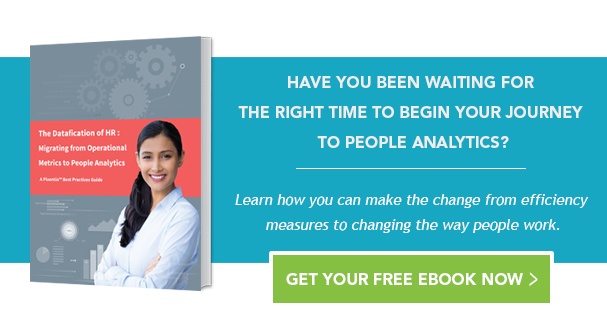
The world has been waiting for HR to jump on the analytics bandwagon. Executives said HR didn’t have the skills and mindset for data-driven people management. Industry wags declared people analytics stuck in neutral, and only a tiny percentage of companies could gain real insights from their data.
Before we pass judgment, consider the way the business intelligence industry delivered analytics—a complicated, expensive process managed and operated by IT. Getting useful information to the people who needed it required a long process of gathering requirements and building data models. Delivery could take months. Too often, the analysis arrived much too late, resulting in lost opportunities on many levels.
Human capital software vendors provided reports and dashboards, but the information looked backward. It didn’t support decisions for future action. Data was locked in functional silos. Turning it into useful information for the business still required a cumbersome BI process.
Can we blame HR for not jumping on that wagon?
The Evolution of Analytics
Two forces reshaped analytics over the past four years: embedded solutions and the democratization of data.
Embedded Analytics
Embedding reports and graphs in business software is not a new idea, but the balance of power has shifted from IT to business users.[1] Now, instead of trying to compete with analytics providers, business software vendors embed state-of-the-art products in their applications. Modern solutions enable providers to configure the front end of analytics solutions to match the usability of the host application. They work seamlessly as an integral part of the business platform.
These embedded solutions contain the tools necessary to connect them to any other business application. Many business application vendors offer pre-built connectors. Standardized custom connections use an application programming interface (API), JavaScript Object Notation (JSON), and representational state transfer (REST) that developers and data analysts understand. Vendors like Workday provide tools any business user can deploy using a few menu-driven steps.

The Democratization of Data
Embedded analytics changed the business model. Instead of requiring companies to buy licenses for a small number of individual users, analytics providers license their solutions to business platforms, making analytics possible for anyone who uses the applications. Executives have search-driven analytics to answer their questions and predictive models to plan future initiatives. At the other end of the organization, an employee who wants to ask for time off using a mobile device has the information and tools they need on-screen. In between are citizen analysts and managers who can develop their own data models to drive better decisions at every level.
A Delicate Balance
The analytics evolution doesn’t mean you need to rip out everything and replace it. The strengths of centralized business intelligence are data governance and security. Distributed data analytics will require new ways of thinking. Every user will have a role in an organization-wide data management, and each user will need to become part of the security solution.
The proliferating market gives us as many deployment models as vendors. No one provider has everything a business needs. It might be best to resist the urge to immediately start evaluating solutions until you have completed an analysis of your current situation and future needs.
Recommendations
Only after a thorough scan of your business model, competitive environment, and data requirements will you be ready to approach a solution. Here are four recommendations to get you started.
- Evaluate business goals and the information you will need to make timely decisions, independent of your current analytical model. Keep in mind that missing a target is important, but missing opportunities can be devastating.
- Understand your current solutions and the analytics roadmap of your business platform providers. Do you have a BI tool that nobody uses? Does your software vendor offer advanced analytics or do you need to connect it to another solution? In each case, consider what information you need that resides outside your functional area.
- Develop learning paths for data users at all levels. The better people understand their data, the more useful their analytics will be. For example, knowing how to join tables is an essential skill. It doesn’t take a data scientist—a business user can learn the basics in half a day.
- Unless your organization already has experience in analytics deployments, it might be prudent to engage an analytics partner to help get you started. Having someone on your team who has experienced the pitfalls and overcome them can be priceless.
References:
 PhenomᵉCloud is a comprehensive technology solutions provider committed to empowering businesses to overcome challenges, enhance their workforce capabilities, and achieve superior outcomes.
PhenomᵉCloud is a comprehensive technology solutions provider committed to empowering businesses to overcome challenges, enhance their workforce capabilities, and achieve superior outcomes.


Leave a Comment